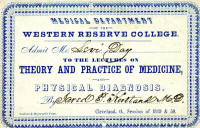Kirtland served from 1828 to 1834 in the Ohio legislature. His true love, however, was natural science and horticulture, not politics. As a child, he managed an arboretum of white mulberry trees, hoping to utilize the trees to cultivate silk worms. In 1845, Kirtland helped found the Cleveland Academy of Natural Science. In 1829, he discovered that scientists had incorrectly identified numerous species of freshwater mussels. Kirtland correctly argued that approximately fifty percent of mussels identified as being their own species, actually belonged in other orders. His discovery shocked the scientific community. Many scholars could not believe that a doctor from Ohio had made such an important discovery. He participated in the Ohio Geological Survey of 1837 and was responsible for zoological aspects of the report.
Kirtland also played an important role in medical education during the mid 1800s. In 1834, he accepted a position at the Medical College of Ohio, teaching the theory and practice of medicine. In 1842, Kirtland took a position at Willoughby College. When the college moved to Cleveland and became the Cleveland Medical College in 1843, Kirtland was one of the original faculty members. He remained with the college until 1864, when he retired from teaching. During the Civil War, he examined the fitness of recruits for military duty and donated his pay to the Soldiers' Aid Society. Kirtland died on December 10, 1877.
